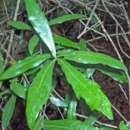en
names in breadcrumbs


Most authors have treated Quercus hemisphaerica as synonymous with Q . laurifolia . M. L. Fernald (1946) carefully examined the situation and concluded that Q . hemisphaerica is a distinct entity, but C. H. Muller (1951) argued that these two taxa "...are now certainly not separable even as varieties of the same species." Later (1970), Muller recanted by recognizing Q . hemisphaerica as a common component of stream terraces along the Gulf Coast.
Quercus hemisphaerica reportedly hybridizes with Q . falcata (C. H. Muller 1970); with Q . arkansana , Q . inopina , Q . marilandica , Q . myrtifolia , Q . nigra , Q . phellos , Q . pumila , and Q . shumardii (D. M. Hunt 1989); and with Q . incana (producing Q . × sublaurifolia Trelease), and Q . laevis (producing Q . × mellichampi Trelease).
Quercus hemisphaerica (sand laurel oak, laurel oak, Darlington oak, laurel-leaf oak) is a species of oak native to the southeastern and south-central United States. It is in the red oak section Quercus sect. Lobatae. It is often confused with and closely related to the Quercus laurifolia (swamp laurel oak) in which it differs in several key characteristics.
Quercus hemisphaerica is a medium-sized evergreen to semi-evergreen tree which can grow as tall as 35 meters (115 feet) tall with a trunk diameter of 1.5 m (5 ft), although it is more commonly around 18–20 m (59–66 ft) tall. The leaves are entire, without teeth except one apical awn (rarely with a few teeth near apex), mostly elliptical or narrowly ovate, and 3–12 centimeters (1+1⁄8–4+3⁄4 inches) long by 1–4 cm (3⁄8–1+5⁄8 in) wide. The petiole is very short ranging from 1–5 millimeters (1⁄16–3⁄16 in) long and the leaf base is obtuse to rounded. The acorns are hemispheric in shape and 9 to 16.5 mm (3⁄8 to 5⁄8 in) by 9 to 16.5 mm (3⁄8 to 5⁄8 in). The acorns take 18 months to mature and are a fourth to a third covered by a saucer- to bowl-shaped cap.[3]
Q. hemisphaerica resembles Quercus laurifolia (swamp laurel oak). They can be distinguished using this criteria.
The tree can be found from Texas to Delaware.[4]
It grows in somewhat xeric sandy soils, sand hills, and sometimes on hillsides.
There is at least one known hybrid involving Q. hemisphaerica which is with Q. laevis (Q. × mellichampii Trel.).
Quercus hemisphaerica (sand laurel oak, laurel oak, Darlington oak, laurel-leaf oak) is a species of oak native to the southeastern and south-central United States. It is in the red oak section Quercus sect. Lobatae. It is often confused with and closely related to the Quercus laurifolia (swamp laurel oak) in which it differs in several key characteristics.